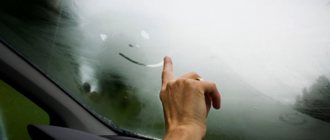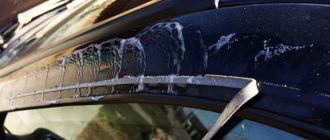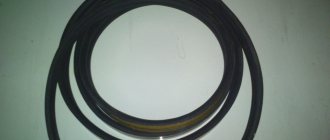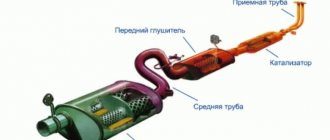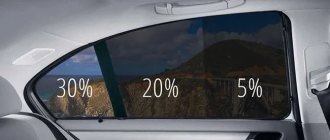Foggy windows are a problem for many cars. It’s not pleasant to look into foggy glass, regardless of its location - front, rear or side. A car window defogger helps solve the problem. You can buy it at an auto chemical store or make it yourself from available materials.
Window fogging is a problem in many older cars. But even new cars may have drops of condensation on the windshield or rear window during rain or snowfall. A car window defogger will help solve the problem. How do anti-fog products work? And how to make such a product on the go, from improvised means?
Why do car windows sweat?
Sweating of the windows inside the car often occurs during rain. It reduces visibility and poses a traffic hazard. Foggy windows block up to 35% of the light flux and thereby reduce the quality of visibility and the driver’s adequate assessment of the road situation. The cause of sweating is condensation. It collects (scientifically, condenses) on the windshield from the inside. It can also be collected on any other glass - side or rear.
Condensation is small droplets of water that settle on the glass surface. Certain conditions are necessary for them to fall out. This is the so-called “dew point”, a combination of a certain humidity and temperature. For example, with an air humidity of 62%, condensation will form at a temperature of +12 °C. But at a humidity of 95%, condensation will appear already at +20 °C. Thus, condensation is guaranteed if there is high humidity in the cabin.
The process of condensation formation can be controlled by temperature and humidity. In this case, the temperature is important not in the cabin, but on the inner surface of the glass. And also air humidity. What do these factors depend on, and how can their values be influenced?
Glass temperature
Determined by the outside air temperature. In winter and autumn it is quite low, so the glass is heated to prevent condensation. Cold glass will almost always be the site of condensation. The glass is heated with warm or hot air from the ventilation slots - this is the same with windshields. Or by transferring heat from heated wires - this is how rear windows are heated.
Condensation does not form on heated glass. If it has already formed, then when the glass is heated, the water droplets dry out within a few minutes. Therefore, in humid weather, the blowing and heating of the windows is turned on immediately, even before leaving the garage, in order to prevent them from fogging up.
Air humidity
The humidity of the air inside the car is the second factor that determines the fogging of the windows. When landing in the cabin, the humidity corresponds to the outdoor space. Afterwards, it may decrease if the hood works well enough.
When you get into your car during a rainstorm, you bring with you 90 percent humidity and condensation on the windows. Therefore, during rain, without waiting for moisture to appear, it is necessary to turn on enhanced exhaust ventilation of the cabin. The amount of moisture in the cabin air will be constantly replenished if 4 - 5 people travel in the car. In 1 minute, a person exhales 1 gram of water, which also remains in the cabin and can condense on the inner surface of the glass. An exhaust fan should also be running to remove moisture from passengers' breath.
A very useful and relevant article from our specialist talks about how a rain sensor works.
You can find out detailed information about whether it is possible to turn on the air conditioner in winter from the article by our author.
We also recommend that you study interesting material from an expert who is devoted to such a pressing issue as anti-rain for car glass.
To remove condensation, it is necessary that the air circulation is turned on “from the machine”. And one more thing: for high-quality ventilation, the cabin filter and evaporator must be clean.
You can also turn on the air conditioner - it will remove moisture and condensation in a few minutes. If the car is just leaving the garage, it will take time to warm up the engine. And only after this it will be possible to heat the glass with hot air. An exception to this rule would be the option of a separately operating stove. In this case, glass heating can be turned on from the start.
How does fogging occur?
Of course, in this case, visibility deteriorates sharply, and the glass changes from transparent to dull-opaque. The driver ceases to see the surrounding situation, and moreover, he is also distracted in order to wipe the glass while driving, thereby increasing the risk of getting into emergency situations. If the windshield and two front side windows are still somehow saved by airflow and heating, then the rear ones simply “perish.”
Most car owners with experience in this regard give many different tips, which boil down to one thing - you need to change the cabin filter. But is this really so? What causes car windows to fog up?
Moisture in the cabin: what to do?
If there is chronic humidity inside the car, it is worth checking the condition of the underbody and raising the rugs. If it is humid under them, the tendency to fog will be increased. What should I do?
- Dry the upholstery under the rugs.
- Place a porous absorbent substance under the driver or passenger seats. Cat litter is often used. Salt also works. It absorbs not only moisture, but also unpleasant odors.
- Check the condition of the seals and, if necessary, change them so that rainwater does not enter the car interior.
- Check the serviceability of the engine cooling system - it can also be a source of moisture for the interior space.
Be sure to read the article about which car lock defroster to buy or how to make it yourself.
Find out what benefits a heated windshield gives a driver and how to install this function correctly in our article.
Folk remedies: what can you rub on the surface of windows to prevent fogging?
We are talking about long-proven methods for removing condensation from glazing. An experienced driver always carries some of the funds with him. However, most of them are sold in regular stores.
If the windshield fogs up from the inside, use:
- Regular table salt. Rub the problem surfaces with its solution, and as a preventative measure, place the dry product in bags on the center console;
- Lemon. Take half a citrus fruit and wipe the glass with it. Fogging will stop, and you will get a pleasant aroma in the cabin;
- Soap (no matter household or toilet). Apply any shapes, drawings, lines to the surface. Use a damp cloth to wipe the glass over the entire area;
- Shaving cream (foam). It is used in exactly the same way as soap, but the process, due to the semi-liquid state of the product, goes faster;
- A solution of alcohol in glycerin in a ratio of 1:20. Treat surfaces with a cotton swab, a clean rag or a spray bottle (the one used to spray plants is suitable).
Before using any of the above methods, the inside of the glass must be wiped with a cloth, sponge or newspaper to remove as much moisture and dirt as possible.
Means for treating foggy glass
To solve the problem of fogging, the automotive industry produces various glass treatment products. They are called anti-fog and anti-rain. They come in the form of aerosols or liquids and are sold in auto chemical stores at an average, affordable price.
Almost any car window defogger is alcohol-based. This is a fairly reliable product that reduces the amount of condensation on the glass and improves visibility during rain. However, there are situations when there is no ready-made anti-fog agent, but you need to go. It’s raining outside, 5 people are sitting in a car, and condensation is constantly forming on the windows. What home remedies can replace auto chemicals?
WD – handy auto chemicals
If an anti-fog agent is a special substance that needs to be bought at a car store, then WD is a rust remover liquid, which is often stored in a car enthusiast’s garage and is used for various purposes. You can also treat glass with WD solvent to prevent it from sweating.
Treat glass using traditional methods
The problem of fogging arose quite a long time ago, so drivers had time to find several options for window treatment using improvised means. One of the most popular is applying a solution of 1 part glycerin and 10 parts alcohol. If you use only glycerin, the glass will become greasy and at night there will be strong reflections in the stains, impairing visibility. Some people advise wiping windows with newspapers - printing ink contains substances that create the same film as when using auto chemicals. Another tip is to rub the windows with tobacco from regular cigarettes.
Auto chemicals: how to use correctly
Store-bought anti-foggers are auto chemical items. Almost all of them are made on the basis of technical alcohol, to which chemical components are added - flavorings, thickeners, preservatives. For the auto chemicals to work effectively, the following rules must be observed.
- The anti-fog agent should be sprayed or applied to clean, washed and dried glass. Definitely dry.
- Can be applied in two or more layers, several times. This will increase the operating time of the product.
- Renew the substance in a timely manner, apply the solution or aerosol anew every 2 weeks.
What else should I treat with anti-fog?
Anti-sweating glass products will be very useful on other surfaces of the car. What else should be treated with an autochemical solution?
- Surface of exterior mirrors. Anti-fog treatment will be similar to anti-rain treatment. During rain or fog, drops will not accumulate on the mirror.
- The outer surface of the glass. This is true for rainy climates or during the season of frequent rainfall. And also for side windows that are not equipped with wipers. During heavy rain, water droplets will quickly roll off the frontal surface. The glass will be clean and visibility will be high.
Reasons why car windows sweat
When the windows become covered with moisture, the driver is forced to take time away from driving the vehicle and periodically wipe the glass with napkins or rags.
Car windows sweat from the inside for the following reasons:
- The difference in the temperature of the environment and the interior space of the cabin. Similar phenomena occur in the cold season or early in the morning, when the air has not yet warmed up. Moisture from the air settles on surfaces in the form of condensation.
- Precipitation. During snowfall and rain, the humidity level inside the car increases. Dampness penetrates into the cabin through open doors, windows, and on the clothes and shoes of the driver and passengers. The fumes come from umbrellas and wet rugs.
- Radiator malfunction. When coolant leaks, a large amount of steam is generated. At the same time, the windshield fogs up, on which oily inclusions appear. It is necessary to stop and check the condition of the cooling system.
- The filter, which is part of the interior air conditioning equipment, is dirty. It may be clogged with dust or oil fumes.
- Consequences of washing a car at a car service center. The interior may not have been properly dried after cleaning.
- Incorrectly configured climate control system or its breakdown. In such cases, the space in the cabin ceases to be dried, and damp air is pumped in.
- Passengers who have consumed large amounts of alcoholic beverages. During breathing, alcohol vapors are released and settle on the windows. Alcohol absorbs water molecules, resulting in condensation.
What the driver should do to prevent the windows from sweating: ways to fix the problem
So, having figured out the reasons why car windows often sweat, you can move on to what to do in such a situation. Of course, the easiest way is to buy a rag and constantly wipe the glass before driving.
You can also constantly turn on the stove, drying the interior. The downside is the long wait for the engine to warm up during a cold start and for the windows to fog up. True, you can constantly turn on the air conditioner (if available), which quickly “dries” the air and removes moisture, but fuel consumption increases, the life of the air conditioning system decreases, etc.
Moreover, this approach of removing moisture with a rag or using air conditioner does not solve the problem itself, but only allows you to get rid of the consequences. If you need a more effective solution, below we will look at ways to avoid fogging.
So, to prevent your car windows from sweating in winter, it is important to understand that the glass itself differs in quality and properties in different cars. It would be good if the car had laminated athermal glass. It’s even better when it is additionally possible to heat the car windows (heated rear window, windshield, etc.).
The presence of glass that is less prone to fogging, as well as their heating, allows you to quickly dry the windows in your car without turning on the heater or air conditioner. Also in winter, heating the windows allows you to quickly clear the outside of the windows from ice and snow. It turns out that if the problem of glass fogging is acute for the driver, this feature must be taken into account at the stage of selecting a car.
- Let's move on. To reduce glass fogging, you also need to periodically service the heating and ventilation system of the car interior, check the operation of the stove, fan, etc. As mentioned above, you need to promptly change the cabin filter and turn off recirculation.
You can also stick a special film on the glass that resembles tinting. This film also has the property of preventing the accumulation of moisture on car windows. In addition, there is another solution - a defogging agent for car windows.
The so-called anti-fog agent for car windows is sold in liquid containers or spray cans. The composition is applied to pre-washed, dried and degreased glass. In practice, the solution is effective, but one application lasts only 10-15 days.
If desired, you can make your own anti-fog at home by mixing denatured or ethyl alcohol with glycerin. The proportions are 20:1, where 1 is glycerin. Then it is better to place the mixture in a spray bottle for ease of application.
How to remove fogged windows in a car?
There are various methods to combat fogging of car windows.
There are general rules for eliminating condensation:
- Adjusting the air conditioning system. It is necessary to ensure that the windows are constantly blown with warm air.
- Installation of several high-quality moisture absorbers in the cabin. Sorbents effectively absorb water from the space, drying it to the required condition.
- Treatment of glass with special agents that have hydrophobic properties. Even water molecules do not linger on them. Such products are produced in the form of aerosols, liquids and impregnated wipes.
- Opening windows a few millimeters. The resulting air circulation ensures the evaporation of condensation from all surfaces.
- Ventilation (air ventilation) and preventive drying of the interior. This helps to dry the upholstery of chairs, rugs and remove liquid accumulated in the niches.
- Regular vehicle maintenance. Timely replacement of filters, sensors and valves will prevent excess moisture.
In the rain
When it rains, water penetrates into the interior of the car, which, when heated, turns into steam, settling on windows, metal and plastic in the form of tiny drops.
You can get rid of glass fogging in inclement weather in the following ways:
- After starting to drive, open the windows on both sides of the car. The resulting turbulence will ensure condensation is blown off the panels.
- After finishing the trip, park the car in a heated garage. If possible, leave windows and doors open to dry out the cabin.
- Before planting, shake off snow and water from clothes and shoes, pack wet umbrellas in plastic bags or covers.
- Before the onset of the wet season, warm up the interior with a hairdryer to remove moisture from the upholstery. When damp air penetrates, the fabric plays the role of a sorbent.
During the winter season
During the cold season, the formation of condensation complicates the already difficult road situation. In addition, there is a risk of sweat freezing and ice crusts forming on the windows.
What you can do:
- Set the maximum heating temperature by directing the air flow to the front panel. Heat in the cab can be eliminated by opening the side windows.
- Use special preparations against condensation formation. Modern anti-fogging solutions for car windows allow you to get rid of this phenomenon without excessive heating of the interior.
- Install electrically heated panels. This will require additional costs, but they are offset by the comfort and safety of travel.
Useful tips
As you can see, in order for the car windows not to sweat in the rain or snow, an important condition is to ensure the most effective ventilation of the interior. In practice, sometimes, instead of waiting for the stove to dry out the moisture, it is better to open the windows a little.
To dry the rear window, you can turn on the heating. If this does not help, then you can install a small fan or interior heater that runs from a car outlet or cigarette lighter.
The cabin filter must be selected strictly for a specific model, and also changed in a timely manner. If you are confident in quality, it is better to give preference to more expensive carbon cabin filters than to cheap analogues from little-known manufacturers. Also, the filter itself must be installed correctly, without creases, distortions, etc.
Also, you should not leave wet or damp things (umbrellas, shoes, jackets, etc.) inside the car. In this case, as it dries, moisture will settle on the glass. It is also recommended to drain the water and thoroughly wipe the rubber mats; heavily wet fabric mats should be removed from the car and dried separately.
Also, especially if the car is in high humidity conditions for a long time, you need to dry the entire interior. This can be done by placing the car in a warm garage or secure parking lot for several days with the windows slightly open.
By the way, you can go to the car wash and at the same time dry-clean the interior if an unpleasant odor appears in the car due to moisture. Specialists will first clean and then thoroughly dry the interior. The simplest solution would be to turn on the heater to maximum, after which you need to drive the car for several hours with the windows slightly open. The main thing is not for the driver to catch a cold if the weather is damp and cold!
If the windows sweat while driving and the heater and/or air conditioner cannot cope with the fogging, it is recommended to drive with the side windows slightly open. Also, if it’s hot in the cabin and cold and humid outside, after the trip it’s better to open all the doors for 5-10 minutes so that fresh air can enter the cabin.
We also recommend reading the article about whether it is necessary to warm up the car engine in winter before driving. From this article you will learn why you need to warm up the engine in winter, how to warm up the engine properly, and how warming up a gasoline and diesel engine differs.
Let us also add that if the driver is transporting passengers who have been drinking alcohol, so that the windows do not sweat, it is optimal to ask such passengers to talk less (if possible), since the alcohol vapor they exhale causes the windows to fog up.
Finally, we note that you should not try to remove frozen ice from the glass using windshield wipers. This can not only damage the wiper blade, but also scratch the glass itself.
To quickly remove ice from glass, it is better to use brushes, carefully remove the ice with a scraper, or use anti-ice products for glass. It is strictly forbidden to pour hot water on frozen glass! In this case, the glass may burst immediately!
Anti-fog films
A good result in the fight against condensation is obtained by covering windows with a special film. The basis of the material is polycarbonate - a polymer with high strength, abrasion resistance and hydrophobic properties. The reverse side has microscopic notches and is smeared with transparent glue. The outer layer repels water molecules, which roll down until a visible layer of perspiration forms.
The gluing process is not particularly difficult. You need to do the following:
- cut a workpiece slightly larger in size than the panel being processed;
- thoroughly wash and degrease the glass, wipe it dry;
- Remove the protective coating from the film, apply it to the panel, and remove air bubbles with a spatula.
Automotive chemicals to get rid of fogging
If your car windows sweat a lot, you can use automotive chemicals. There is a line of products that get rid of condensation. They help prevent fogging - just apply them to the windshield and windows once every 3-4 weeks. By treating surfaces inside and out, you can reduce the risk of visibility impairment to a minimum.
How do defoggers work?
Special products are called differently, the most common names being “anti-rain”, “anti-fog” or “anti-condensation”. They operate on the same principle: enhancing the water-repellent properties of the glass itself. The main component of anti-fog agents is a special type of technical alcohol. After processing, a microfilm is formed on the surface of the glass, preventing the accumulation of condensation. The liquid only moistens the windshield and windows without blurring the view. Visibility becomes slightly worse, but not as critical as with fogging
What types of funds are there?
Depending on the consistency, auto chemicals for combating condensation are available in the form of:
- Liquids. Typically, such products are available in spray bottles for ease of handling. They differ in their action: those designed to repel moisture are best used for external treatment; products that prevent the formation of moisture are suitable for use inside the car. The liquid must be sprayed onto a clean and dry glass surface, and then thoroughly rubbed with a rag or napkins. Please note that the napkin fabric should not be fleecy.
- Mastic. The denser the consistency of the product, the better it works. If you are willing to spend more money to get a longer lasting effect, choose mastics. They are applied in the same way as a liquid, only the texture resembles a gel or paste.
Note! Do not ignore the instructions for using the product: many products cannot be used inside the car; they can only be used to treat glass outside.
Prevention of glass fogging
To avoid condensation, you should follow a few simple rules:
- Before boarding the cabin in conditions of heavy rainfall, place pieces of cellophane, old linoleum or unnecessary rags on top of the mats. They will collect water from the shoes, which can then be easily removed from the interior.
- Before a long trip, pre-rub the glass with mastic, glycerin or another long-acting product. Always have a supply of anti-icing and de-icing agents on your windows.
- Periodically dry upholstery and rugs. Dry things can act as a sorbent for a long time.
These methods will reduce the humidity in the cabin and reduce the likelihood of windows fogging in any weather conditions.
In the autumn-spring, and even in the winter, car windows very often sweat (even in new and working cars). There are many reasons for this, and a stove or air conditioner does not always help. Therefore, now a lot of different “anti-foggers” have been “thrown” onto the car cosmetics market, which help fight this phenomenon. BUT not all of them cost adequately, and some simply do not work. Today I will tell you a recipe for such a composition with my own hands, and for mere pennies...
All the remedies below have been tested by me personally and really work. They can be used not only in a car, but also for swimming goggles or home windows. However, some work better, some worse.
Regular soap
If anyone doesn't believe it, try applying it to the windows. This is an old, ancient method that has been working for years (by the way, soldiers used it to treat the glass in gas masks so that they would not sweat).
The principle of application is simple. You need to apply the “mesh” with a bar of soap to the car windows and then rub it well. The composition works reliably, the efficiency is HIGH.
There are also disadvantages - you can only do this in warm weather, because it is VERY difficult to grind such a mesh in the cold
Shaving foam or gel
Personally, I myself use this method and I think that this is the best do-it-yourself anti-fog for the money. And the most important thing is that both are available in almost every home and there is no need to spend extra money on purpose.
Application method - you will need paper towels (gel works better, not much, but still). Squeeze out a little and rub the glass. Next, take a dry towel and treat the surface until transparent.
The efficiency is the highest. Almost no cons
Now watch the video version
In conclusion, I would like to say that these anti-fog recipes will of course help you, but if it’s damp on your rugs and especially under them, you can squeeze it out, then you need to first dry the interior and then treat it, otherwise the effect will be much worse.
You can also advise putting some cat litter in a small bag, say under the seat, it will absorb excess moisture and keep it inside. You need to change it about once a week or two (it will simply swell).
This is where I end, I think my article and video were useful to you. Subscribe to the channel, read AUTOBLOG.
( 9 votes, average: 5.00 out of 5)
Similar news
Evaporation of antifreeze and other causes of its leakage. Let's take the fur off.
The antifreeze (TOSOL) has darkened and turned brown. Why? Let's analyze the wasps.
Do-it-yourself anti-freeze. How to make for a car, methods with spir.
“>
